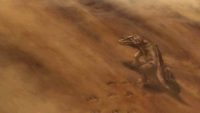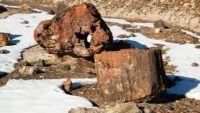Is a dinosaur still a dinosaur if it has flight feathers? A new study points to some fascinating evidence that contradicts the idea of feathered dinosaurs and confirms created kinds. It’s no secret that birds fly in order to, among other reasons, get food and avoid becoming food. For that, they must have their feathers arranged in good order. But feathers wear out. If birds replaced their feathers haphazardly, for example, to… More… …read more Source: icr.org
It may not need tectonics or climate change. …read more Source: creation.com
A new way of looking at your world. …read more Source: creation.com
Exciting rock formations show that fossils form naturally much faster than we are conditioned to believe. …read more Source: creation.com
By Ken Ham Every year, hordes of tourists descend on Grand Canyon to enjoy the natural beauty of this geological wonder. But many tourists hiking the popular Bright Angel Trail missed something very interesting—a series of fossilized footprints preserved in a boulder, lying next to the trail, that had broken off a cliff in the nearby Manakacha Formation. But in 2016, a geology professor hiking with his students noticed the footprints, and now research on these tracks has been released. One of the scientists who studied these tracks, Stephen Rowland, shares: These are by far the oldest vertebrate tracks in [More]
Why it all depends on what is meant by ‘age’. …read more Source: creation.com
Ways they make conflicting results tell the same story. …read more Source: creation.com
These geological structures form much more quickly than was thought! …read more Source: creation.com
By Ken Ham Did small mammals scavenge dinosaur bones? A new study looked at tiny bite marks on the bones of massive long-necked dinosaurs, the sauropods, and concluded small scavenging mammals gnawed away at the bones. This makes sense within the context of the global flood. Eventually, rising floodwaters buried those remains, drowning and perhaps burying the scavengers along with them. As the floodwaters rose, dinosaurs and other creatures were drowned. Some were rapidly buried by the sediments carried in the water. Others drowned, and their decaying carcasses washed up on shore, where scavengers nibbled on a free meal. Eventually, [More]
By William Worraker The biblical and scientific arguments for a pre-Flood vapour canopy do not support the theory. …read more Source: AIG Daily
Are scientists always objective? Do they always interpret the evidence with an open mind? Some time ago I experienced first-hand how a scientist’s beliefs affect the way he looks at the evidence. Whilst a geology student at university, I needed to identify a fossil. After consulting the Atlas of Invertebrate Macrofossils 1 I had tentatively identified it as a belemnite2 of the genus Hibolites. However, paleontology was not my specialty so I sought advice from an expert. …read more Source: creation.com
A new study published in Nature Ecology & Evolution has claimed that flowering plants, the most common type of plant on Earth, first appeared in small numbers in rocks of the Early Cretaceous. Fossils indicate that these plants became extremely abundant in rocks of the post-Cretaceous (or Cenozoic) after the dinosaurs disappeared in the rock record.1 However, creation scientists interpret these findings much differently. W… More… …read more Source: icr.org
Vance Nelson’s latest book is impressive and like his previous works, contains a lot of original research accompanied with really beautiful pictures. A lot of time has gone into research and his photographic efforts. The book is written in an engaging and non-technical manner, and Vance took care to define his terms for lay readers. Summary: . …read more Source: creation.com
Evolutionary timeframes date the moon at about 4.5 billion years, with the lunar volcanism that produced the large, prominent and nearly circular, dark “seas” (or maria, as they are called) starting soon after that. The volcanism is mooted to have ended about three billion years ago. But researchers studying recent images of the far side of the moon, taken from the Japanese SELENE (Kaguya) lunar satellite, report dark “seas” of volcanic rock they say are “only” 2.5 billion years old, “much younger” than formerly presumed.1,2 That’s because there are fewer craters (blasted by meteors) on the smooth dark surfaces than [More]
The Salt Range of Pakistan has yielded some very interesting fossils-that according to evolution should not have been found! …read more Source: creation.com
Two of the remotest places ever visited by humans are the moon and the deepest part of the ocean. Earth’s lowest point is called the “Challenger Deep,” a depression inside the southern end of the Mariana Trench—the deepest point in the western Pacific Ocean, located in the territorial waters of the Federated States of Micronesia, east of the Mariana Islands. Kelly Walsh, th… More… …read more Source: icr.org
Surprising catastrophism in sediments for uniformitarians; is it consistent with the Flood? …read more Source: creation.com
No! That was early during Noah’s Flood and continents still existed …read more Source: creation.com
Folded, bent and deformed rock layers across the globe testify to catastrophe on an unimaginable scale. …read more Source: creation.com
The growth rings in Paleozoic corals are often used to support the idea that the earth is very old, but the argument was flawed from the beginning. …read more Source: creation.com
In order for the bizarre theory of evolution to be validated, evolutionists must show how inorganic non-life organized itself into carbon-based (organic) life. They also must show how major transitions in animals occurred, including how fish became the first tetrapods. This means fish fins would need to slowly turn into feet and legs. As one secular journal said, “The evolution of fishes into tetrapods—four-legged vertebrates of which… More… …read more Source: icr.org
Did octopus fossil ink really survive millions of years? …read more Source: creation.com
By Ken Ham When we think rainforests, we think tropical, sunshine (and lots of it), and frequent rains. We don’t think of frigid winds, bone-chilling temperatures, and icy seawaters. But that’s where the remains of a fossil rainforest were found—on the continent known for penguins instead of tropical parrots: Antarctica! A new study found tropical fossils, similar to the current flora in New Zealand’s South Island, in Cretaceous layers. Now, this isn’t the first time the remains of seemingly out-of-place organisms have been found on the southernmost continent. But a new study found tropical fossils, similar to the current flora [More]
While searching for a missing plane on the ocean floor, scientists made an interesting geological discovery. On March 8, 2014, Malaysia Airlines flight MH330 disappeared with all 239 people on board somewhere over the southern Indian Ocean. So far, no pieces of the plane have ever been found on the ocean floor. From 2014 to 2016, three vessels collected detailed sonar images over a large piece of the Indian Ocean whi… More… …read more Source: icr.org
Scientists recently discovered evidence that large theropods were possibly guilty of cannibalism.1 The new study, published in PLOS ONE, examined over 2,300 bones from the Mygatt-Moore Quarry in western Colorado.1 It was led by Stephanie Drumheller, from the Department of Earth and Planetary Sciences, the University of Tennessee, Knoxville, and several colleagues. The scientists determined that about … More… …read more Source: icr.org
A new analysis of thousands of deep earthquakes has revealed several large structures at the base of the mantle.1 Known as ultra-low velocity zones, these structures may give us better insight into the origins of hot spots which produced the Hawaiian Islands during the Flood year. Doyeon Kim from the University of Maryland and his colleagues analyzed over 6,000 shear (S-waves) waves from earthquakes deeper than … More… …read more Source: icr.org
Scientists from China, Sweden, and Australia have discovered what they claim is the oldest known parasite, publishing their results in Nature Communications.1 The evidence comes from small tube-shaped objects attached to the shells of the host brachiopods.2 Scientists speculate that these tubes contained some sort of parasitic worm. Parasites are “nutritionally dependent upon the host for at lea… More… …read more Source: icr.org












































